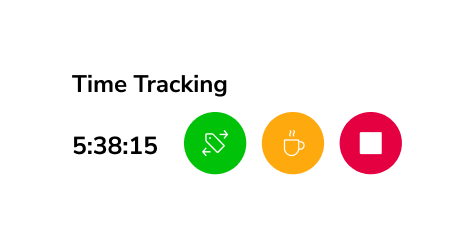What Is Time Theft and How Can You Prevent It?
Theft in the workplace is more common than many realize. According to Business.com’s survey on the state of workplace time theft in 2025, 67% of the 1,000 American workers they polled admitted to having committed at least one type of theft at their current job.
This isn’t just limited to taking physical items like office supplies or equipment. Another valuable resource that employees sometimes steal is time.
Understanding and addressing time theft is crucial for companies to maintain fairness, efficiency, and trust in the workplace. This article will explore what time theft really means, the common ways it happens, and practical steps businesses can take to prevent it.
Let’s get into it.

Photo by Brad Neathery on Unsplash
What Is Time Theft?
Time theft happens when employees are paid for work hours they didn’t actually complete. This can be on purpose or by mistake, but either way, it adds up and hurts the business.
Time theft can take many forms, from buddy punching (clocking in for someone else), taking extended breaks, to working slower on purpose or using work hours for personal tasks. This invisible loss adds up, impacting productivity and increasing labor costs.
What Is the Penalty for Time Theft?
The consequences of time theft depend on how serious the situation is. If an employee accidentally forgets to clock out once or twice, it’s usually treated as a simple mistake.
However, if someone intentionally steals time repeatedly or commits large-scale time theft, the penalties can be much harsher. According to Morgan & Morgan‘s employment law article on time theft, if time theft involves more than $1,000, it can be classified as a felony, which may lead to heavy fines and even prison time, up to ten years in some cases.
Beyond legal consequences, time theft is often grounds for termination. Some employees have been fired for suspected time theft.
To better understand the legal repercussions of time theft, let’s look at this case:
- Employee pays employer over $2000 for over 50 hours of unexplained time entries
In the case of Reach v. Besse, the BC Civil Resolution Tribunal dismissed an employee’s wrongful dismissal claim and instead awarded damages to the employer.
Ms. Besse, an accountant working remotely for Reach CPA Inc., was found to have reported over 50 hours on timesheets that were not supported by activity data from time-tracking software. After being confronted, she failed to explain the discrepancies and was terminated for just cause.
The employee filed a claim for $5,000 for wrongful dismissal, unpaid wages, and severance. The employer counterclaimed about $1,500 for wages paid during time theft and $1,000 owed from an advance for home office equipment.
The Tribunal ruled that time theft is serious misconduct, especially in remote work settings where trust is key, and ordered Ms. Besse to reimburse the employer for wages paid for unworked hours and outstanding advances.
This totaled to approximately $1,500 for wages paid for unworked hours, plus about $1,000 owed on an advance for home office equipment, totaling around $2,750, including interest and fees.
Lessons Learned:
- Time theft damages the employment relationship, particularly in remote work environments where supervision is limited. Time theft can also be used as a grounds for dismissal if in violation with workplace policies.
- Reliable time tracking software can provide strong evidence of time theft, but it should be used in compliance with privacy laws and workplace policies.
- Having transparent electronic monitoring policies helps employers protect themselves legally and supports fair enforcement of work-hour tracking, especially when remote work is involved.
How Can You Detect Time Theft?
Detecting time theft starts with paying close attention to employee work patterns and data. One effective way is to compare the hours employees report with their actual productivity. For example, if a worker’s output, like the number of tasks completed or calls made, is much lower than expected for the hours they claimed, it could be a sign of time theft.
Using workforce analytics tools and time tracking software can make this easier by spotting unusual patterns across individuals or the whole team.
Additionally, cross-checking clock-in and clock-out times with security camera footage or access logs can provide clear evidence of whether employees were physically present during the hours they reported.
Even if you think your workplace is safe from time theft, analyzing time and productivity data helps uncover hidden issues before they become bigger problems.
What are the Effective Ways To Prevent Time Theft?
1. Set clear goals and expectations
When employees know exactly what’s expected of them and have clear deadlines, they’re more focused and less likely to waste time. Clear goals keep everyone accountable and help reduce opportunities for time theft.
Make sure these expectations are documented, communicated regularly, and tied to measurable outcomes. Regular check-ins or progress updates can also help ensure everyone stays on track and aligned with company priorities.
2. Use automated time tracking tools
Whether it’s buddy punching, fudging hours, or forgetting to log time accurately, relying on outdated methods leaves your business vulnerable to time theft and payroll errors. That’s where automated time tracking software comes in. It not only ensures accurate clock-ins and clock-outs but also helps you maintain accountability across your team.
But don’t just pick any time tracking tool. When choosing a system to manage time and attendance, look for features specifically designed to prevent misuse and support workforce transparency.
Key features to consider include:
-
Biometric verification (such as facial recognition or fingerprint scanning) to eliminate buddy punching and ensure that the right person is clocking in.
-
GPS tracking to verify employee location during clock-ins, particularly useful for remote teams or field workers.
-
Real-time alerts to flag missed, late, or irregular clock-ins so managers can respond quickly.
-
Audit logs and reporting tools that provide a clear, tamper-proof record of time entries for compliance and review.
Investing in the right solution not only protects your business but also helps boost productivity and accountability across your team.
3. Monitor productivity, not just hours
A 40-hour workweek with little to no meaningful output doesn’t benefit anyone. That’s why it’s important to track what gets done, not just when someone is working.
By evaluating employee output alongside their logged hours, you can spot inconsistencies that might otherwise go unnoticed. For example, if someone regularly logs full shifts but consistently misses deadlines or delivers minimal work, it’s worth digging deeper. It could be a sign of poor time management or deliberate manipulation.
To do this effectively, consider using a time tracking system with project management and productivity monitoring features. These can allow you to:
- Take screenshots during work hours to get a better visual of how work is being done.
- Monitor which tools or platforms are being used during work hours, helping identify distractions or misuse of time.
- Categorize time entries directly to specific projects or deliverables, making it easier to assess productivity in terms of actual output.
Tracking employee output alongside hours worked helps spot mismatches that could signal time theft. If someone’s tasks or results don’t match the time they logged, it’s a good reason to investigate.
4. Limit unnecessary breaks and meetings
Encouraging employees to take regular, healthy breaks is essential for maintaining focus and preventing burnout, but there’s a fine line between restorative breaks and excessive downtime. Long or frequent unscheduled breaks can chip away at productivity and create a culture of disengagement.
To strike the right balance, set clear guidelines around break times. Encourage short, intentional pauses that help employees recharge without disrupting workflow. Tools like scheduled break reminders or productivity timers can help promote structured and efficient rest periods.
Similarly, meetings should serve a clear purpose, not become a drain on time and energy. Unstructured or overly frequent meetings can quickly consume large chunks of the workday. To prevent meetings from running excessively long, try to set clear agendas, invite only necessary participants, and replace unnecessary meetings with quick updates via email or messaging tools.
5. Boost employee morale and engagement
Employees who feel valued, trusted, and motivated are far less likely to engage in time theft. A disengaged team is more prone to clock-watching, cutting corners, or mentally checking out during the day.
To reduce this risk, focus on building a positive, supportive work culture. Recognize and reward good performance, provide opportunities for growth, and listen to employee feedback.
At the end of the day, engaged employees are more invested in their work and more accountable with their time.
Ready To Prevent Time Theft in the Workplace?
Time theft is definitely something that businesses shouldn’t ignore. While a few minutes here and there might seem harmless, over time, it can lead to significant productivity loss and financial losses. Clear policies, transparent communication, and the right tools for tracking time can help prevent time theft issues before they even escalate.
By taking proactive steps now, you can create a more accountable workplace, protect your bottom line, and ensure that every minute on the clock counts toward moving your business forward.


